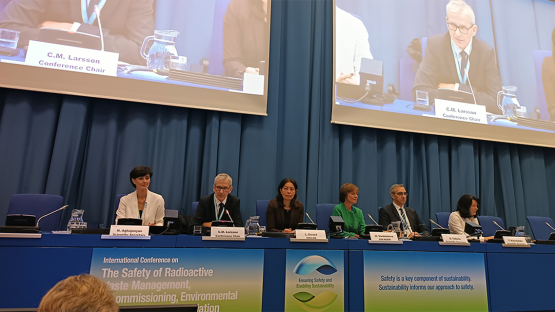Over 600 policy makers, regulators, owners and operators of nuclear and radiation facilities, as well as representatives from non-governmental organizations and academic institutions are participating in discussions at the International Conference on the Safety of Radioactive Waste Management, Decommissioning, Environmental Protection and Remediation: Ensuring Safety and Enabling Sustainability.
The weeklong conference that opens today will cover various thematic topics — on the management of radioactive waste, environmental protection, decommissioning of facilities using radioactive materials, and remediation of contaminated areas — and draw attention to the relationship between safety and sustainability.
“There are many opportunities for nuclear science and technology to contribute to sustainable development if we get it right – in particular, if it is safe throughout its lifecycle,” said Lydie Evrard, IAEA Deputy Director General and Head of the Department of Nuclear Safety and Security in her opening remarks, noting that “it is important to generate awareness on this relationship between safety and sustainability. Relevant interested parties: regulators, operators, governments, play a vital role as do the public who ultimately play an essential role in the acceptance and development of safe and sustainable solutions for the uses of nuclear technologies and applications.”
Through its mandate to accelerate and enlarge the contribution of atomic energy to peace, health and prosperity, the IAEA actively supports countries in their efforts to reach United Nations Sustainable Development Goals (SDGs). The use of nuclear science and technology contributes directly to nine of the 17 SDGs, in areas including energy, human health, food production, water management and environmental protection. The safe management of radioactive waste, environmental releases, decommissioning, and remediation is key to ensuring that the use of nuclear science and technologies is itself sustainable.
The interconnection between safety and sustainability is a systemic and dynamic one as they both influence each other. Enabling the sustainable use of nuclear applications requires optimization of the related protection and safety parameters and at the same time, the optimisation of protection and safety is anchored in the three pillars of sustainability.
“The concepts of circular economy—trying to keep resources in use for as long as possible by reducing, reusing and recycling them—are becoming increasingly mainstream in the decommissioning of nuclear facilities using radioactive materials,” said Olena Mykolaichuk, Director of the IAEA’s Division of Nuclear Fuel Cycle and Waste Technology. “Adopting such principles can provide significant drivers for minimizing waste, increasing efficiency and enhancing sustainability, thereby reducing the environmental impact and conserving resources for future generations.”
At the conference, participants will also learn about one of the ways in which the IAEA supports its Member States to strengthen the sustainable uses of nuclear applications through nuclear safety— which is through the peer reviews and advisory services it offers. One such service is the Integrated Review Service for Radioactive Waste and Spent Fuel Management, Decommissioning and Remediation (ARTEMIS) that offers independent expert opinion and advice based on the IAEA safety standards, technical guidance and international good practices.
Another important area that will be discussed at the conference is the IAEA safety standards that serve as a global reference for protecting human health and the environment. These safety standards highlight that the societal, economic and environmental aspects should also be taken into account and be integrated with safety aspects in a holistic way in the decision-making processes for sustainable development.
“Whichever way you look at it, safety – safety throughout the lifetime of nuclear science and technology – is intrinsically integrated with sustainable development,” said Evrard adding that “the safety standards also reflect this influence of sustainability on safety.”
The IAEA conference is being held in cooperation with the European Commission (EC), European Bank for Reconstruction and Development (EBRD), International Commission on Radiological Protection (ICRP), OECD Nuclear Energy Agency (NEA) and the United Nations Environment Programme (UNEP).
“It is timely to consider carefully the implications of Agenda 2030 and the Sustainable Development Goals for the international framework for safety,” said Carl-Magnus Larsson, the Conference Chair. “By learning from decommissioning, waste management, remediation, and environmental protection, we may position ourselves better in carrying out future activities in a way that is safe and sustainable,” he added.







